ULURU
Hi There!
Well we were on our way to Uluru, previously known as Ayres Rock. What would we see? What would we feel? How would we react when we saw the rock? Is this the ultimate destination in Australia? Lots of questions, I know, but relevant I would think. The boys were excited, the other half was excited. Me? Not sure. I wonder what people over the world would think of when prompted about Australia? When questioned would they say yes, we know of the Great Barrier Reef, the Sydney Opera House and yes Kangaroo’s. Malcolm Turnbull? Bob Hawke? Paul Hogan? Sorry! I digress. Would they say, Ayres Rock(Uluru)? I somehow think that yes Uluru would be near or at the top of the list. I think for most of us Australians its a pilgrimage of sorts. Not sure if that’s true or not but most people have either been or want to go and I’m sure there’s some that just couldn’t be bothered. I must admit that as we drew closer to seeing the “Rock” the excitement level was rising. You don’t see much from the road as you approach Yulara(town/resort next to Uluru), but it’s still a “WOW” moment when you catch that first glimpse. Here’s this great monolith of a rock that just protrudes from the surrounding landscape in what is practically the centre of Australia. Yes I know it’s not the geographical centre of Australia, that’s only about 300km away as the crow flies. We did notice four-wheel drive vehicles up on top of the sand dunes getting clear views of the Rock, but we were pressing on to the Yulara and the Ayres Rock Resort-Ayres rock Campground.
That’s an oxymoron if ever there was one! Resort, ha! Not this campground. Else where maybe if you were paying big bucks at one of the fine and dandy accommodation resorts. You see, we hadn’t booked a campsite. Mind you we had rung about 4 days out but it was fully booked out, great I thought! “Don’t worry” they said, ‘just turn up and you can find a spot in the overflow section and its only $10 dollars a night”. Click, click, mental arithmetic happening, 3 nights, 10 dollars a night, got it, $30 bucks, gee that’s cheap, end of mental arithmetic. They also said get there early in the day to get the best spots(aka-closest spots to the amenities block in the actual campground). We have noticed in the Northern Territory that at the big campgrounds there are queuing up lanes to get in and they are usually full towards the end of the day or even after lunch! So we got there in the early afternoon and a bonus we didn’t have to wait too long and we were in looking for the overflow section. I guarantee you that the overflow section was in the vicinity of 10-20 times bigger than the actual campground and the front section(aka-closest to the amenities block) was virtually full. If you ever want to see what caravans and camper trailers are in use around Australia this would be the place to go! We found a spot amongst some small scrubby plants including Grevillea and set up camp, got the binoculars out to look for the amenities block and discovered them about 600 metres away! Time to set up a shuttle bus to get to the toilet!!
 Not a great picture but this is the Shanty Town-Overflow section or most of it!. Below is the section closest to the amenities on the right which you cant see and we are located in the left of this picture. The Khaki setup on the left at the front. The funny thing is that this overflow virtually empties and fills every day, which is not surprising when you see the amount of travellers on the road! There was also some campers here in this section that obviously were spending a week or two here and they had worked their way to the front of the overflow section therefore being only 40-50 metres away from the amenities. They were also from the Territory and obviously knew about the cheap overflow section.
Not a great picture but this is the Shanty Town-Overflow section or most of it!. Below is the section closest to the amenities on the right which you cant see and we are located in the left of this picture. The Khaki setup on the left at the front. The funny thing is that this overflow virtually empties and fills every day, which is not surprising when you see the amount of travellers on the road! There was also some campers here in this section that obviously were spending a week or two here and they had worked their way to the front of the overflow section therefore being only 40-50 metres away from the amenities. They were also from the Territory and obviously knew about the cheap overflow section.
 The sun was now starting to sink and the park had a sunset viewing area of the rock. So off we trundled with the crowds to have a look. The area was slightly busy, so we worked our way along the dunes until we had our own mostly private viewing area. This is what we saw! At last, Uluru in all its glory.
The sun was now starting to sink and the park had a sunset viewing area of the rock. So off we trundled with the crowds to have a look. The area was slightly busy, so we worked our way along the dunes until we had our own mostly private viewing area. This is what we saw! At last, Uluru in all its glory.
 Again with different colours.
Again with different colours.
 A bit later.
A bit later.
 And now no sun. Beautiful!
And now no sun. Beautiful!

How is it that Uluru changes colour so much? Well, the answer is quite simple. The colour changes as a result from the effects of the earths atmosphere on the suns incoming rays. Dust, ash and water vapour in the atmosphere act as a filter which can remove the bluer light from the suns rays, allowing redder light through at different times of the day. When the sun is directly overhead, the suns rays only have to pass through a thin atmosphere therefore minimising the filtering effect. Whereas in the mornings or evenings when the sun is low on either horizon, the suns rays have to travel through a thicker layer of atmosphere to reach a certain point on the earths surface. The light reaching Uluru at sunset or sunrise is mainly from the red end of the spectrum and its reflection from the rock and clouds in the sky cause the spectacular colours. The surrounding landscape further enhances these effects.
 A peculiar plant caught my eye on these dunes know as Green Bird flower, Crotalaria cunninghamii. This shrub growing between 1 and 3 metres is found in inland areas on red sand dunes. Can be erect or sprawling with velvety stems. Large yellow-green flowers striped with fine black or purple pin strips are present on terminal racemes to 22cm in length during winter and spring.
A peculiar plant caught my eye on these dunes know as Green Bird flower, Crotalaria cunninghamii. This shrub growing between 1 and 3 metres is found in inland areas on red sand dunes. Can be erect or sprawling with velvety stems. Large yellow-green flowers striped with fine black or purple pin strips are present on terminal racemes to 22cm in length during winter and spring.

 Time to head back to camp and cook tea. Check out the amazing colour of the dirt(sand really!).
Time to head back to camp and cook tea. Check out the amazing colour of the dirt(sand really!).
Today was a holiday in the Northern Territory, Territory Day! This is the only day of the year you can buy fireworks and let them off in the Northern Territory!! We had been warned and sure enough well into the night and even early next morning fireworks were going off everywhere at Yulara. What a racket! Could only imagine what it would be like in Alice Springs or even Darwin! The next morning greeted us with drizzly rain and puddles. What a day to visit Uluru, yuck, it wasn’t looking good.
 We made our way to Uluru-Kata Tjuta National Park getting glimpses of a wet rock on the way. It still looked amazing and impressive in the landscape.
We made our way to Uluru-Kata Tjuta National Park getting glimpses of a wet rock on the way. It still looked amazing and impressive in the landscape.

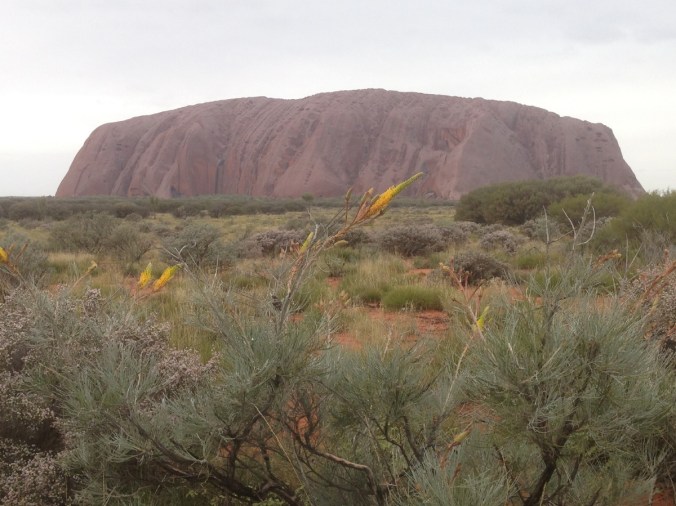 Here are some Honey Grevillea’s, Grevillea eriostachya, these were everywhere around Uluru, flashes of brilliant yellow amongst a red and green background. Grows to about 3 metres and flowers for a long time in winter and spring. We made our way to the Cultural centre to escape the rain and learn more of Uluru and the Anangu Land which is run by the traditional landowners who are the Yankunyjatjara and Pitjantjatjara people. From the guide-book, “This land was created by the creation ancestors. In their travels they left marks in the land and made laws for us to keep and live by. We hope that during your visit you will learn about some of our ancestors and culture. Please respect this knowledge and open your minds and hearts so you can really appreciate our enduring culture” There were lots of things to see and do in the Cultural Centre. I overheard a tourist asking a Park employee what was worth looking at Uluru during the rain. The response was “do the Mala walk, it has brilliant waterfalls during wet weather”. So off we trundled into the rain to do the Mala Walk. Its only 2km return and flat, so very easy. Our plan had been to cycle around Uluru but the hire company doesn’t operate in the wet. As we had two bikes with us, we needed another 4. That wasn’t going to work, was it! Back to the Mala walk, Mala is Aboriginal for Rufous hare-wallaby. Click HERE to see what it looks like. Could be an overgrown rat crossed with a Hare!! In this section there were sheer vertical cliffs which were impressive.
Here are some Honey Grevillea’s, Grevillea eriostachya, these were everywhere around Uluru, flashes of brilliant yellow amongst a red and green background. Grows to about 3 metres and flowers for a long time in winter and spring. We made our way to the Cultural centre to escape the rain and learn more of Uluru and the Anangu Land which is run by the traditional landowners who are the Yankunyjatjara and Pitjantjatjara people. From the guide-book, “This land was created by the creation ancestors. In their travels they left marks in the land and made laws for us to keep and live by. We hope that during your visit you will learn about some of our ancestors and culture. Please respect this knowledge and open your minds and hearts so you can really appreciate our enduring culture” There were lots of things to see and do in the Cultural Centre. I overheard a tourist asking a Park employee what was worth looking at Uluru during the rain. The response was “do the Mala walk, it has brilliant waterfalls during wet weather”. So off we trundled into the rain to do the Mala Walk. Its only 2km return and flat, so very easy. Our plan had been to cycle around Uluru but the hire company doesn’t operate in the wet. As we had two bikes with us, we needed another 4. That wasn’t going to work, was it! Back to the Mala walk, Mala is Aboriginal for Rufous hare-wallaby. Click HERE to see what it looks like. Could be an overgrown rat crossed with a Hare!! In this section there were sheer vertical cliffs which were impressive.

 It was simply stunning to see Uluru in the rain. It had stopped mostly but the waterfalls were still running albeit slower and smaller. I have since seen photos after and during major deluges on Uluru which show water cascading down everywhere in huge quantities.
It was simply stunning to see Uluru in the rain. It had stopped mostly but the waterfalls were still running albeit slower and smaller. I have since seen photos after and during major deluges on Uluru which show water cascading down everywhere in huge quantities.
 Everywhere you turned to look at Uluru you would see different colours in the rock and this changes as the sun rises and sets on it as well.
Everywhere you turned to look at Uluru you would see different colours in the rock and this changes as the sun rises and sets on it as well.

 Cave right at the base of Uluru
Cave right at the base of Uluru
 Notice above how the rain has changed the colour of the rock
Notice above how the rain has changed the colour of the rock What is Uluru composed of? “Uluru is composed of arkose, a coarse-grained sandstone rich in the mineral feldspar. The sandy sediment, which hardened to form this arkose, was eroded from high mountains composed largely of granite” , this is quoted from the online Department of the Environment and Energy. Click HERE if you want to know more of the Geology of Uluru. An interesting piece of information is that Uluru is a visible tip of a huge rock slab that extends possibly 6 kilometres underground! The exposed bit is supposed to be the biggest exposed rock going around, imagine if it was all exposed!!
What is Uluru composed of? “Uluru is composed of arkose, a coarse-grained sandstone rich in the mineral feldspar. The sandy sediment, which hardened to form this arkose, was eroded from high mountains composed largely of granite” , this is quoted from the online Department of the Environment and Energy. Click HERE if you want to know more of the Geology of Uluru. An interesting piece of information is that Uluru is a visible tip of a huge rock slab that extends possibly 6 kilometres underground! The exposed bit is supposed to be the biggest exposed rock going around, imagine if it was all exposed!!


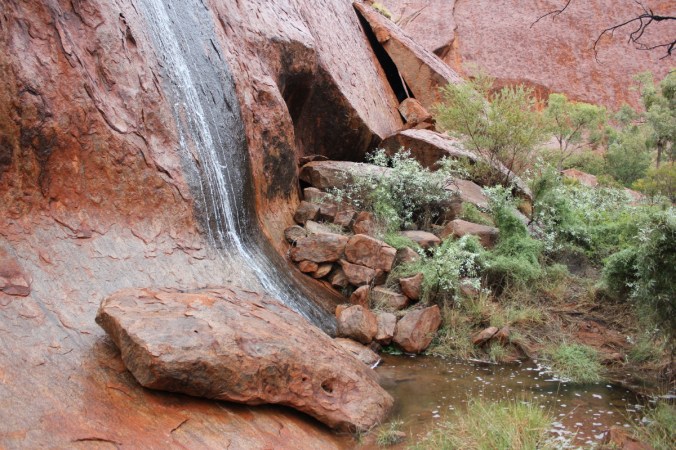
Waterfalls everywhere!

 Crystal clear water.
Crystal clear water.
 Beautiful scenery where ever you turned. Below is Kantju Gorge a wonderful location with a lovely waterfall.
Beautiful scenery where ever you turned. Below is Kantju Gorge a wonderful location with a lovely waterfall.

Not much to say really, simply enchanting. We then drove around to the sunset/sunrise viewing area which is on the opposite side to the Mala walk and here you get a completely different aspect of Uluru.
 Another view from the sunset/sunrise viewing area.
Another view from the sunset/sunrise viewing area.
 The Wattle above is Acacia ligulata, also known as Umbrella Bush, this grows to about 4 metres.
The Wattle above is Acacia ligulata, also known as Umbrella Bush, this grows to about 4 metres.
 When you look closely at the surface of Uluru, it looks like its flaking and it is. This is caused by a chemical decay of minerals. The rusty colour of the exposed surface of these flakes is caused by the oxidation (rusting) of the iron in the Arkose. Fresh Arkose is grey in colour. Some more examples below.
When you look closely at the surface of Uluru, it looks like its flaking and it is. This is caused by a chemical decay of minerals. The rusty colour of the exposed surface of these flakes is caused by the oxidation (rusting) of the iron in the Arkose. Fresh Arkose is grey in colour. Some more examples below.

 Below is Ptilotus obovatus, a lovely little shrub to about 1 metre high and across has pink flowers frequently after rain. Often seen on shallow stony ground. The leaves are covered with star-shaped hairs giving the plant a silvery appearance. I saw this one on the Kuniya Walk, which is an easy walk to the Mutijulu Waterhole home of Wanampi, an ancestral water snake.
Below is Ptilotus obovatus, a lovely little shrub to about 1 metre high and across has pink flowers frequently after rain. Often seen on shallow stony ground. The leaves are covered with star-shaped hairs giving the plant a silvery appearance. I saw this one on the Kuniya Walk, which is an easy walk to the Mutijulu Waterhole home of Wanampi, an ancestral water snake.
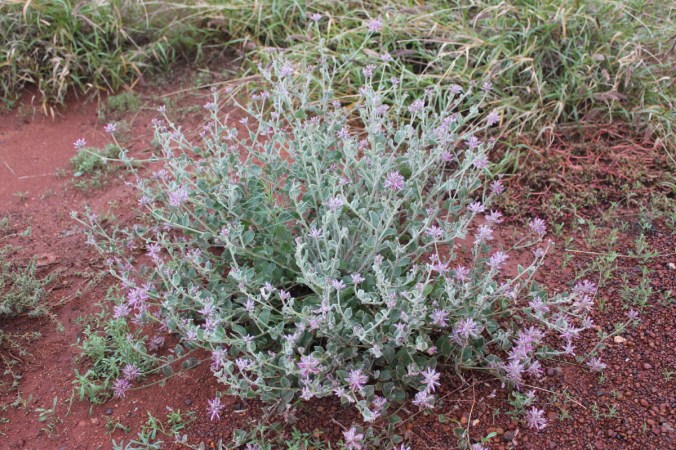 Closeup of Ptilotus flowers
Closeup of Ptilotus flowers Here is the Mutitjula Waterhole, another special place at Uluru.
Here is the Mutitjula Waterhole, another special place at Uluru.
 The photo below in some way summed up Uluru for us. The comment was made something along the lines of “look its breathing” or something of that effect. Well! It did sort of feel alive, maybe it was just the flow of Arkose Sandstone and how it was shaped or how the rain ran off it, maybe its cultural significance, even its history over time or maybe all of the previous combined. It just felt significant. I can now understand why the traditional owners revere it. This is a special place.
The photo below in some way summed up Uluru for us. The comment was made something along the lines of “look its breathing” or something of that effect. Well! It did sort of feel alive, maybe it was just the flow of Arkose Sandstone and how it was shaped or how the rain ran off it, maybe its cultural significance, even its history over time or maybe all of the previous combined. It just felt significant. I can now understand why the traditional owners revere it. This is a special place.
 Here’s a few more plants I noticed on our travels around Uluru.
Here’s a few more plants I noticed on our travels around Uluru.
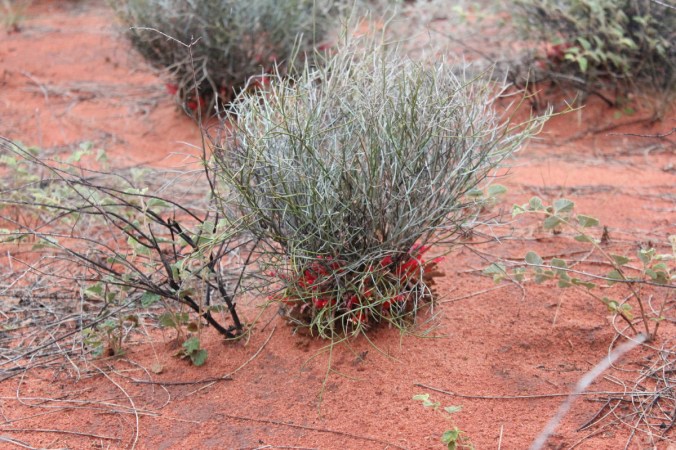 This is Upside down plant, Leptosema chambersii. Obviously you can see how it got its common name. It’s a bit topsy turvy with the flowers at the bottom. A small shrub with leaves reduced to scales. Lives on sand plains and dunes normally with Triodia sp. Closeup below.
This is Upside down plant, Leptosema chambersii. Obviously you can see how it got its common name. It’s a bit topsy turvy with the flowers at the bottom. A small shrub with leaves reduced to scales. Lives on sand plains and dunes normally with Triodia sp. Closeup below.


Another interesting plant was Bush Plum, Santalum lanceolatum, it grows to about 7 metres as a shrub or small tree on a wide variety of habitats and flowers throughout the year. Fruit is usually eaten straight from the tree, older branches are also harvested for sandlewood.

 This one below is one of the Triodia species, usually quite a sharp and prickly clumping grass
This one below is one of the Triodia species, usually quite a sharp and prickly clumping grass
 The large trees around Uluru were Desert Bloodwood, also known as Corymbia terminalis .
The large trees around Uluru were Desert Bloodwood, also known as Corymbia terminalis .
 There were also a large Grevillea called Beefwood. Grevillea striata.
There were also a large Grevillea called Beefwood. Grevillea striata.

Well the day was coming to an end and we hadn’t done everything we wanted to due to the weather and consideration for children. We were damp, tired and pretty chuffed that we had finally made it to this legend of our great southern land, Uluru, a monolithic breathing living monstrous rock.
Finally, a last parting glance for this day at this magical place known as Uluru.
 Cheers!
Cheers!
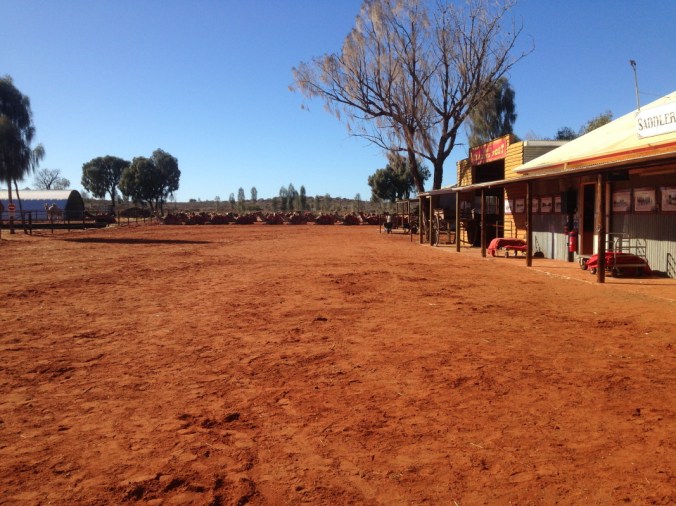 Here’s a few lined up ready to go on some long tours, we were only going to do the 20 minute version.
Here’s a few lined up ready to go on some long tours, we were only going to do the 20 minute version. Old Tom’s waterhole, not sure who old Tom is. You can see our rig in the car park all packed and ready to head south(home).
Old Tom’s waterhole, not sure who old Tom is. You can see our rig in the car park all packed and ready to head south(home). getting up close with our ride! Here we go!
getting up close with our ride! Here we go! Time to head towards the Stuart Highway and start our 2,381 kilometre journey home!
Time to head towards the Stuart Highway and start our 2,381 kilometre journey home! Right it is!
Right it is! A far too common sight on the side of the Stuart Highway. Rolled and crashed vehicles, obviously too expensive to retrieve out here, wont be long and they will be scavenged and rusted away in this harsh landscape. Another common sight is road trains, the lifeblood of the outback! Click HERE for some interesting information on road trains.
A far too common sight on the side of the Stuart Highway. Rolled and crashed vehicles, obviously too expensive to retrieve out here, wont be long and they will be scavenged and rusted away in this harsh landscape. Another common sight is road trains, the lifeblood of the outback! Click HERE for some interesting information on road trains. A couple more photos of these largish trucks!.
A couple more photos of these largish trucks!. Not real great fun overtaking them either as you watch the individual trailers moving around!
Not real great fun overtaking them either as you watch the individual trailers moving around! We were heading for Marla, 5ookm away in South Australia, our first stop on the way home. When we set up camp behind the Road House we realised there were seven of us instead of the usual six. We had picked up a hitch hiker!
We were heading for Marla, 5ookm away in South Australia, our first stop on the way home. When we set up camp behind the Road House we realised there were seven of us instead of the usual six. We had picked up a hitch hiker! Poor little fellow, thought he might like a holiday, we caught him and placed him on the side of a tree at Marla much to the disgust of our youngest who thought we could take him home.
Poor little fellow, thought he might like a holiday, we caught him and placed him on the side of a tree at Marla much to the disgust of our youngest who thought we could take him home. Next morning we continued south to Coober Pedy to have a look at this interesting place, click HERE to find out more about this bizarre place! You know you are getting close when you come across these mounds.
Next morning we continued south to Coober Pedy to have a look at this interesting place, click HERE to find out more about this bizarre place! You know you are getting close when you come across these mounds. There is some serious mining for Opals here, it is also known as the opal mining capital of the world with over 70 opal fields. To me the unfortunate thing is it leaves the landscape looking like the above and below photo’s, interesting but quite ugly!
There is some serious mining for Opals here, it is also known as the opal mining capital of the world with over 70 opal fields. To me the unfortunate thing is it leaves the landscape looking like the above and below photo’s, interesting but quite ugly! There are a lot of houses here that are mostly underground or partially underground to escape the searing heat experienced here. You can see the ventilation shafts in the photo below.
There are a lot of houses here that are mostly underground or partially underground to escape the searing heat experienced here. You can see the ventilation shafts in the photo below.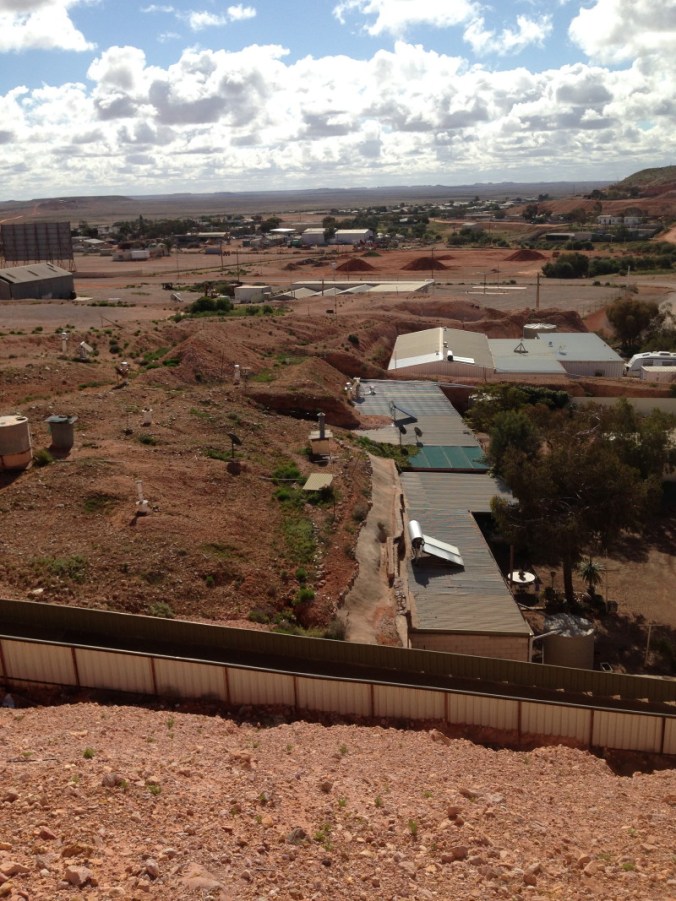 Here’s a panoramic view from the lookout.
Here’s a panoramic view from the lookout. Another view.
Another view. Time to move on. unfortunately we found Coober Pedy to be dirty, unappealing and creepy. Not a glowing endorsement considering plenty of other people find it amazing. I should also say that we didn’t do any of the underground mine tours or building tours, apparently these are quite good. We can recommend the Coober Pedy Outback Bar and Grill, we had a really great lunch! Time to hit the road again and get as far along as we could before it got dark.
Time to move on. unfortunately we found Coober Pedy to be dirty, unappealing and creepy. Not a glowing endorsement considering plenty of other people find it amazing. I should also say that we didn’t do any of the underground mine tours or building tours, apparently these are quite good. We can recommend the Coober Pedy Outback Bar and Grill, we had a really great lunch! Time to hit the road again and get as far along as we could before it got dark. Another road photo, not really exciting. Lots of road to look at.
Another road photo, not really exciting. Lots of road to look at. Last night on the side of the road, plenty of firewood required for a nice warm fire!
Last night on the side of the road, plenty of firewood required for a nice warm fire!
 Toasty feet.
Toasty feet. It was a cold windy night. We had one more night before we got home and we decided to book a house at a campground which was sort of nice not to have to unpack and set up the camper trailer, a last night of luxury. Sort of! I apologise for all the blurry/grainy photos above, they were all taken on a IPhone 5a, b or c, who would know…Well after 6500 kilometres and three weeks on the road, it was great to be home with a whole heap of memories and experiences which we shall never forget for all the right reasons! Now the fun starts…..Unpacking!!
It was a cold windy night. We had one more night before we got home and we decided to book a house at a campground which was sort of nice not to have to unpack and set up the camper trailer, a last night of luxury. Sort of! I apologise for all the blurry/grainy photos above, they were all taken on a IPhone 5a, b or c, who would know…Well after 6500 kilometres and three weeks on the road, it was great to be home with a whole heap of memories and experiences which we shall never forget for all the right reasons! Now the fun starts…..Unpacking!! That’s just me with my family poking fun at me, never seemed to have the camera away from my eyes! Oh, and a small bald spot!
That’s just me with my family poking fun at me, never seemed to have the camera away from my eyes! Oh, and a small bald spot!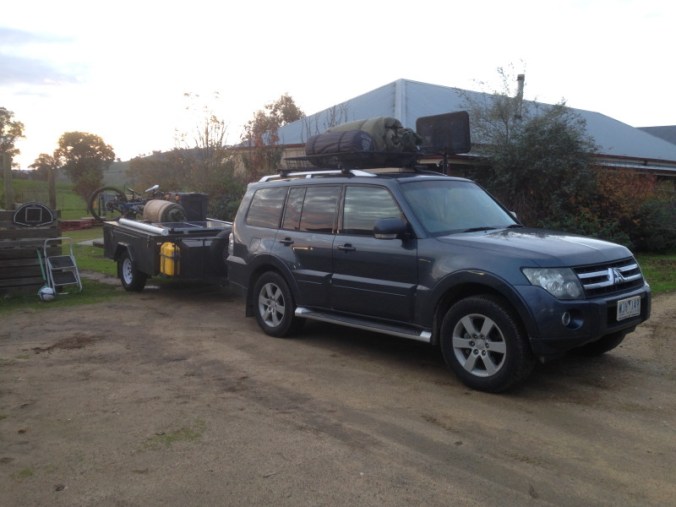 Part 2 – Alice Springs – Olive Pink Botanic Garden
Part 2 – Alice Springs – Olive Pink Botanic Garden
 Part 4 – National Road Transport Hall of Fame.
Part 4 – National Road Transport Hall of Fame. Part 5 – Alice Springs Desert Park
Part 5 – Alice Springs Desert Park Part 6 – Alice Springs, a few last glimpses.
Part 6 – Alice Springs, a few last glimpses.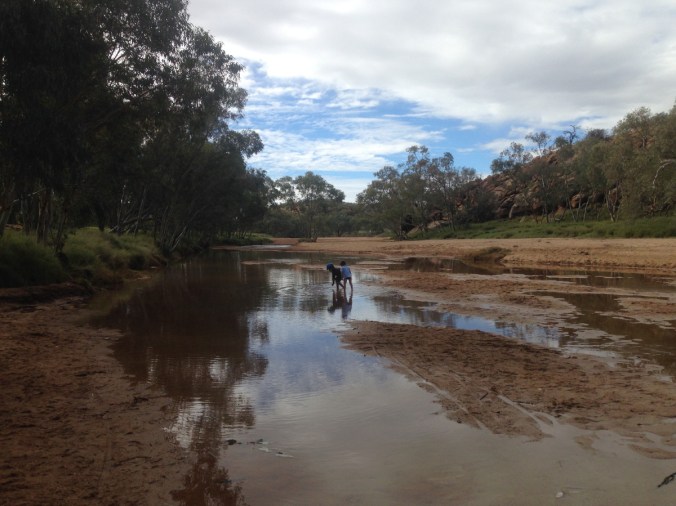 Part 7 – Serpentine Gorge
Part 7 – Serpentine Gorge Part 8 – Ormiston Gorge and the Ochre Pits
Part 8 – Ormiston Gorge and the Ochre Pits Part 9 – Kings Canyon
Part 9 – Kings Canyon Part 10 – Kathleen Gorge
Part 10 – Kathleen Gorge Part 11 – Uluru
Part 11 – Uluru Part 12a – Kata Tjuta – Valley of the Winds
Part 12a – Kata Tjuta – Valley of the Winds Part 12b – Kata Tjuta – Walpa Gorge
Part 12b – Kata Tjuta – Walpa Gorge Part 13 – You’re already on it!!
Part 13 – You’re already on it!! I will finish here with a tribute to the Northern Territory using lyrics from a hugely popular and loved classic of the screen and Broadway. I couldn’t have said it better!!
I will finish here with a tribute to the Northern Territory using lyrics from a hugely popular and loved classic of the screen and Broadway. I couldn’t have said it better!! Not a great picture but this is the Shanty Town-Overflow section or most of it!. Below is the section closest to the amenities on the right which you cant see and we are located in the left of this picture. The Khaki setup on the left at the front. The funny thing is that this overflow virtually empties and fills every day, which is not surprising when you see the amount of travellers on the road! There was also some campers here in this section that obviously were spending a week or two here and they had worked their way to the front of the overflow section therefore being only 40-50 metres away from the amenities. They were also from the Territory and obviously knew about the cheap overflow section.
Not a great picture but this is the Shanty Town-Overflow section or most of it!. Below is the section closest to the amenities on the right which you cant see and we are located in the left of this picture. The Khaki setup on the left at the front. The funny thing is that this overflow virtually empties and fills every day, which is not surprising when you see the amount of travellers on the road! There was also some campers here in this section that obviously were spending a week or two here and they had worked their way to the front of the overflow section therefore being only 40-50 metres away from the amenities. They were also from the Territory and obviously knew about the cheap overflow section. The sun was now starting to sink and the park had a sunset viewing area of the rock. So off we trundled with the crowds to have a look. The area was slightly busy, so we worked our way along the dunes until we had our own mostly private viewing area. This is what we saw! At last, Uluru in all its glory.
The sun was now starting to sink and the park had a sunset viewing area of the rock. So off we trundled with the crowds to have a look. The area was slightly busy, so we worked our way along the dunes until we had our own mostly private viewing area. This is what we saw! At last, Uluru in all its glory. Again with different colours.
Again with different colours. A bit later.
A bit later.
 A peculiar plant caught my eye on these dunes know as Green Bird flower, Crotalaria cunninghamii. This shrub growing between 1 and 3 metres is found in inland areas on red sand dunes. Can be erect or sprawling with velvety stems. Large yellow-green flowers striped with fine black or purple pin strips are present on terminal racemes to 22cm in length during winter and spring.
A peculiar plant caught my eye on these dunes know as Green Bird flower, Crotalaria cunninghamii. This shrub growing between 1 and 3 metres is found in inland areas on red sand dunes. Can be erect or sprawling with velvety stems. Large yellow-green flowers striped with fine black or purple pin strips are present on terminal racemes to 22cm in length during winter and spring.
 Time to head back to camp and cook tea. Check out the amazing colour of the dirt(sand really!).
Time to head back to camp and cook tea. Check out the amazing colour of the dirt(sand really!).
 We made our way to Uluru-Kata Tjuta National Park getting glimpses of a wet rock on the way. It still looked amazing and impressive in the landscape.
We made our way to Uluru-Kata Tjuta National Park getting glimpses of a wet rock on the way. It still looked amazing and impressive in the landscape.
 Here are some Honey Grevillea’s, Grevillea eriostachya, these were everywhere around Uluru, flashes of brilliant yellow amongst a red and green background. Grows to about 3 metres and flowers for a long time in winter and spring. We made our way to the Cultural centre to escape the rain and learn more of Uluru and the Anangu Land which is run by the traditional landowners who are the Yankunyjatjara and Pitjantjatjara people. From the guide-book, “This land was created by the creation ancestors. In their travels they left marks in the land and made laws for us to keep and live by. We hope that during your visit you will learn about some of our ancestors and culture. Please respect this knowledge and open your minds and hearts so you can really appreciate our enduring culture” There were lots of things to see and do in the Cultural Centre. I overheard a tourist asking a Park employee what was worth looking at Uluru during the rain. The response was “do the Mala walk, it has brilliant waterfalls during wet weather”. So off we trundled into the rain to do the Mala Walk. Its only 2km return and flat, so very easy. Our plan had been to cycle around Uluru but the hire company doesn’t operate in the wet. As we had two bikes with us, we needed another 4. That wasn’t going to work, was it! Back to the Mala walk, Mala is Aboriginal for Rufous hare-wallaby. Click
Here are some Honey Grevillea’s, Grevillea eriostachya, these were everywhere around Uluru, flashes of brilliant yellow amongst a red and green background. Grows to about 3 metres and flowers for a long time in winter and spring. We made our way to the Cultural centre to escape the rain and learn more of Uluru and the Anangu Land which is run by the traditional landowners who are the Yankunyjatjara and Pitjantjatjara people. From the guide-book, “This land was created by the creation ancestors. In their travels they left marks in the land and made laws for us to keep and live by. We hope that during your visit you will learn about some of our ancestors and culture. Please respect this knowledge and open your minds and hearts so you can really appreciate our enduring culture” There were lots of things to see and do in the Cultural Centre. I overheard a tourist asking a Park employee what was worth looking at Uluru during the rain. The response was “do the Mala walk, it has brilliant waterfalls during wet weather”. So off we trundled into the rain to do the Mala Walk. Its only 2km return and flat, so very easy. Our plan had been to cycle around Uluru but the hire company doesn’t operate in the wet. As we had two bikes with us, we needed another 4. That wasn’t going to work, was it! Back to the Mala walk, Mala is Aboriginal for Rufous hare-wallaby. Click 
 It was simply stunning to see Uluru in the rain. It had stopped mostly but the waterfalls were still running albeit slower and smaller. I have since seen photos after and during major deluges on Uluru which show water cascading down everywhere in huge quantities.
It was simply stunning to see Uluru in the rain. It had stopped mostly but the waterfalls were still running albeit slower and smaller. I have since seen photos after and during major deluges on Uluru which show water cascading down everywhere in huge quantities. Everywhere you turned to look at Uluru you would see different colours in the rock and this changes as the sun rises and sets on it as well.
Everywhere you turned to look at Uluru you would see different colours in the rock and this changes as the sun rises and sets on it as well.
 Cave right at the base of Uluru
Cave right at the base of Uluru Notice above how the rain has changed the colour of the rock
Notice above how the rain has changed the colour of the rock What is Uluru composed of? “
What is Uluru composed of? “



 Crystal clear water.
Crystal clear water. Beautiful scenery where ever you turned. Below is Kantju Gorge a wonderful location with a lovely waterfall.
Beautiful scenery where ever you turned. Below is Kantju Gorge a wonderful location with a lovely waterfall.
 Another view from the sunset/sunrise viewing area.
Another view from the sunset/sunrise viewing area. The Wattle above is Acacia ligulata, also known as Umbrella Bush, this grows to about 4 metres.
The Wattle above is Acacia ligulata, also known as Umbrella Bush, this grows to about 4 metres. When you look closely at the surface of Uluru, it looks like its flaking and it is. This is caused by a chemical decay of minerals. The rusty colour of the exposed surface of these flakes is caused by the oxidation (rusting) of the iron in the Arkose. Fresh Arkose is grey in colour. Some more examples below.
When you look closely at the surface of Uluru, it looks like its flaking and it is. This is caused by a chemical decay of minerals. The rusty colour of the exposed surface of these flakes is caused by the oxidation (rusting) of the iron in the Arkose. Fresh Arkose is grey in colour. Some more examples below.
 Below is Ptilotus obovatus, a lovely little shrub to about 1 metre high and across has pink flowers frequently after rain. Often seen on shallow stony ground. The leaves are covered with star-shaped hairs giving the plant a silvery appearance. I saw this one on the Kuniya Walk, which is an easy walk to the Mutijulu Waterhole home of Wanampi, an ancestral water snake.
Below is Ptilotus obovatus, a lovely little shrub to about 1 metre high and across has pink flowers frequently after rain. Often seen on shallow stony ground. The leaves are covered with star-shaped hairs giving the plant a silvery appearance. I saw this one on the Kuniya Walk, which is an easy walk to the Mutijulu Waterhole home of Wanampi, an ancestral water snake. Closeup of Ptilotus flowers
Closeup of Ptilotus flowers Here is the Mutitjula Waterhole, another special place at Uluru.
Here is the Mutitjula Waterhole, another special place at Uluru. The photo below in some way summed up Uluru for us. The comment was made something along the lines of “look its breathing” or something of that effect. Well! It did sort of feel alive, maybe it was just the flow of Arkose Sandstone and how it was shaped or how the rain ran off it, maybe its cultural significance, even its history over time or maybe all of the previous combined. It just felt significant. I can now understand why the traditional owners revere it. This is a special place.
The photo below in some way summed up Uluru for us. The comment was made something along the lines of “look its breathing” or something of that effect. Well! It did sort of feel alive, maybe it was just the flow of Arkose Sandstone and how it was shaped or how the rain ran off it, maybe its cultural significance, even its history over time or maybe all of the previous combined. It just felt significant. I can now understand why the traditional owners revere it. This is a special place. Here’s a few more plants I noticed on our travels around Uluru.
Here’s a few more plants I noticed on our travels around Uluru. This is Upside down plant, Leptosema chambersii. Obviously you can see how it got its common name. It’s a bit topsy turvy with the flowers at the bottom. A small shrub with leaves reduced to scales. Lives on sand plains and dunes normally with Triodia sp. Closeup below.
This is Upside down plant, Leptosema chambersii. Obviously you can see how it got its common name. It’s a bit topsy turvy with the flowers at the bottom. A small shrub with leaves reduced to scales. Lives on sand plains and dunes normally with Triodia sp. Closeup below.


 This one below is one of the Triodia species, usually quite a sharp and prickly clumping grass
This one below is one of the Triodia species, usually quite a sharp and prickly clumping grass The large trees around Uluru were Desert Bloodwood, also known as Corymbia terminalis .
The large trees around Uluru were Desert Bloodwood, also known as Corymbia terminalis . There were also a large Grevillea called Beefwood. Grevillea striata.
There were also a large Grevillea called Beefwood. Grevillea striata.













 Cheers!
Cheers!